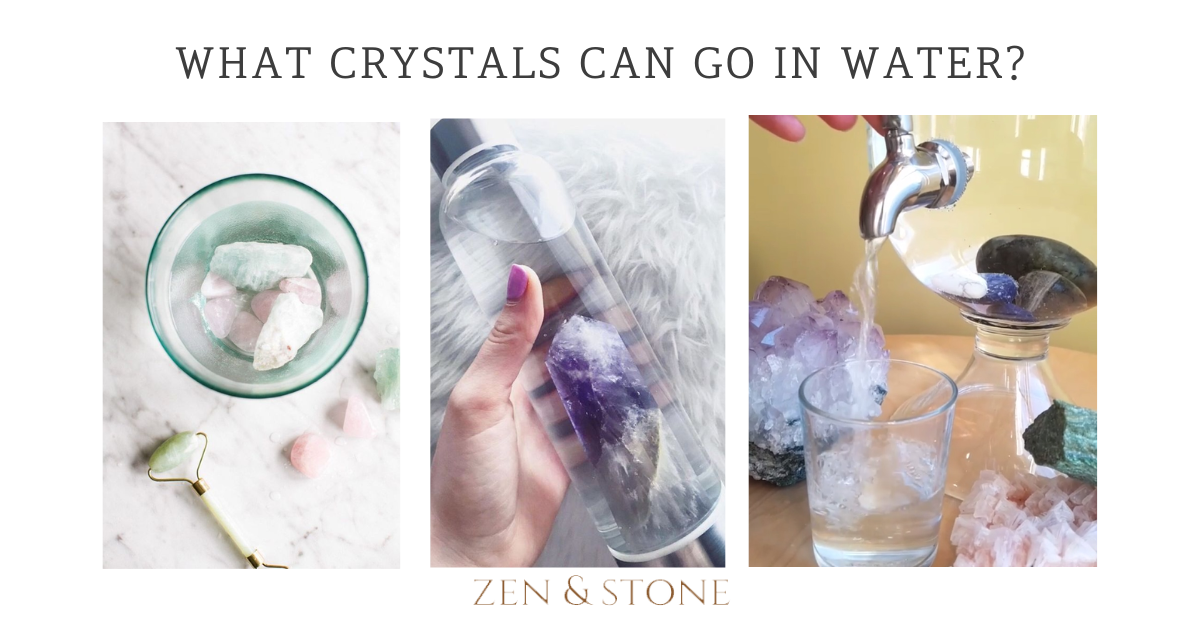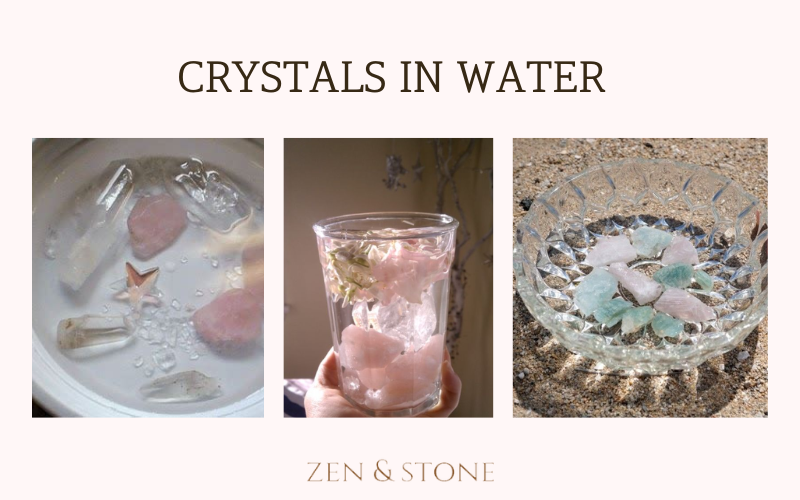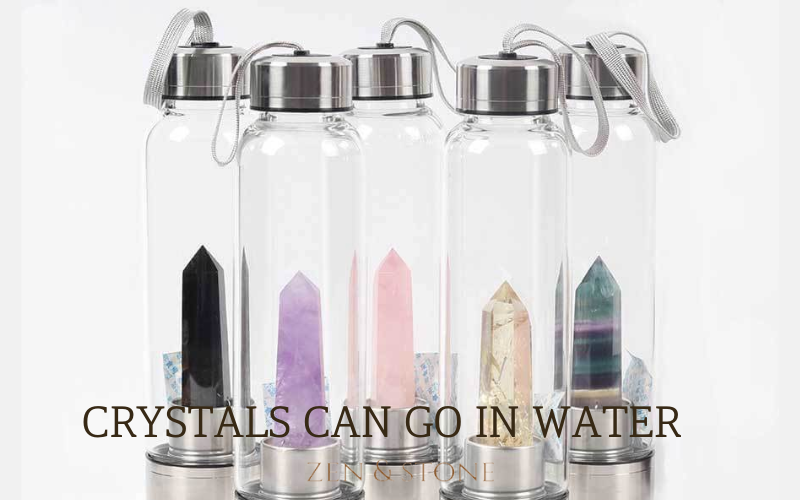
01 May What Crystals Can Go In Water?
Water can be a great tool for crystal healing, but not all of them can go in the water. In fact, it can actually cause certain crystals to lose their luster, or even dissolve. So, which ones can go in the water and which ones cannot? Let’s take a look.
Why use crystals in water?
If you are familiar with crystal healing, you probably know that cleansing and charging your crystals is essential. It gets rid of any negative energy absorbed by them and recharges them with positive energy for better healing.
Every crystal is different and benefits from different methods of cleansing and charging, and certain crystals can be cleansed and charged in water, some even work best when used with the element.
How to cleanse crystals with water
There are several tried and tested methods of cleansing crystals, such as leaving them in the light of the full moon and smudging them with a sage stick, but you can also add water to the mix by submerging them in water whilst they bathe in the moonlight, washing them under tap water or salt-water, or even leaving them out in the rain.
How to charge crystals with water
Common ways to charge crystals include burying them in the Earth and leaving them outside in the sunlight. You can add water to the mix by putting them in a bowl of water or salt-water as they bathe in the sun or by burying them in the Earth on a rainy day.
Using crystal-infused water
You can even place your crystals in your bath or drink a glass of crystal-infused water by leaving it in a glass of water overnight.
Drinking crystal water helps you to absorb the stone’s healing properties from the inside out, and bathing in it helps to soak it up through your skin. Both are great practices – especially for people born under water signs like Scorpio and Pisces. For these people, it may help them connect with their crystals even more.
What makes crystals water safe?
Crystals are water safe if they are high on the Mohs Hardness scale. This is a scale that ranks the hardness of certain minerals by testing their resistance.
The harder the mineral, the higher it is on the scale. Any crystal that scores a 5 or below on the Mohs hardness scale should not be put in water as it is not hard enough to withstand it and could disintegrate or dissolve.

Which crystals are safe in the water?
Now that we’ve explained how to use crystals with water, let’s take a look at some strong, water-safe crystals, including quartz crystals, amethyst, and more.
Agate
Agate rebalances the body, the mind, and the soul. There are lots of different types of Agate stones, and they all have different healing qualities and benefits that target different chakras and areas of your life, but they all have calming properties and they’re all pretty tough, hard crystals.
Obsidian
Obsidian is a protective stone that keeps negative energy away. It’s great for the home, and to keep on your person. It also has grounding properties that can keep you thinking clearly and keep you connected to the Earth.
Rose Quartz
Rose Quartz is a popular pretty pink stone that is known for its heart-charka healing qualities and its ability to nurture self-love and improve relationships in its users.
Smoky Quartz
These Quartz crystals are great for letting go of fear and negative thoughts and emotions, as well as promoting peace and motivation in its users.
Clear Quartz
Another member of the quartz family, Clear Quartz is known to be a master healer. It’s a great starter stone, and a good all-rounder for cleansing your space, your energy, and the alignment of all of your chakras for overall peace and clarity.
Amethyst
Another good starter stone and all-rounder, Amethyst is great for spiritual and emotional healing of all kinds, as well as enhancing your spiritual connection, aligning your crown chakra, and even aiding headache relief.
Jasper
Another hard crystal, Jasper is a nurturing stone that is full of energy to balance your life and awaken your soul, your passions, and your life purpose.
Aventurine
Aventurine promotes success, wealth, and a sense of inner empowerment. It’s also good for enhancing leadership qualities and healing the heart.
Tiger’s eye
Tiger’s eye strengthens the mind; great for creating healthy boundaries, improving focus, clarity, and intuition, and improving decision-making skills.
Citrine
Citrine is a good-luck stone; it is known for its ability to enhance optimistic thinking and positivity, as well as self-esteem, good fortune, strengthening endurance, and improving digestion.

Moonstone
Moonstone is as gorgeous as it sounds and it’s great for feminine energy. It is linked to softness, intuition, clarity, and brings light, hope, and overall nurturing and empowerment to anybody who uses it.
Aquamarine
Aquamarine is a stone of courage; it’s known for its calming properties that reduce stress, quieten the mind, invoke tolerance, and give people encouragement in hard times.
Carnelian
Carnelian is linked to the lower chakras. It’s an incredible stone for manifestation as it enhances your energy and vibration whilst inspiring creativity and confidence. It’s also a cleansing stone so you can use it to cleanse your other crystals. Although it can go in water, it should not go in salt-water.
Which crystals work best with water?
Crystals like the ones we mentioned above can be utilized with water, but there are certain stones that work especially well with the element because they’re associated with it in some way.
Crystals such as blue agate, amethyst, moonstone, and rose quartz are all associated with water, and so using them in combination with the element will make them even more powerful in your practices.
Which ones cannot go in the water?
Unfortunately, not all crystals can go in water – some crystals dissolve and others’ appearances can become damaged by exposure to the element. Let’s take a look at some soft crystals to avoid mixing with water.
Fluorite
Fluorite is a purifying stone that brings purity to the mind as well as physical health. It does not fully dissolve in water but leaving it in water for even a short period of time can cause the formation of pores in the stone.
Black Tourmaline
Black tourmaline is a protector against negative energies. It absorbs and dissipates them, protecting you and your space from anything unwanted. When placed in water, however, it won’t fully dissolve but it can be damaged.
Pyrite
Pyrite is another powerful protection stone that shields against negative vibrations and energies. It also stimulates the intellect and enhances memory but it’s rich in iron, so it can rust when it spends too much time in the water.
Calcite
Calcite is an amplification stone; known for its ability to amplify your vibration and open up your consciousness, nurture your third eye chakra and awaken your psychic abilities. It’s also said to cleanse and improve the function of the kidneys, pancreas, and spleen, as well as improve eyesight.
However, it’s not recommended for use with water because it’s low on the Mohs hardness scale and the surface can be damaged by the element, reducing its shine and color.
Angelite
Angelite can be used to improve spiritual awareness. It has a peaceful energy that is calming and soothing for users, and it also promotes better communication skills, as well as self-expression, freedom from anger, and fearlessness.
It should not go in the water because it’s too low on the Mohs hardness scale and it’s likely to crumble and dissolve.
Selenite
Selenite has deep healing properties that help to remove energetic blockages, promoting peace and elevating your overall aura. It is not safe for use in water because it can dissolve entirely if it’s submerged for long enough, and it’s also one of a few toxic crystals that can be damaging to drink when infused with water.
Celestine
Celestine is used for connecting with the angelic realm and transforming negative energy into peace and serenity. However, it cannot go in the water because it will cause damage to the surface of the stone.
Topaz
Topaz soothes, heals, aligns, and recharges the meridians of the body, directing positive energy to where it is needed the most. It promotes honesty, forgiveness, joy, love, generosity, success, wealth, and good health, but it is too fragile for use with water.
Kyanite
Kyanite attunes the mind; stimulating logical thought and mental healing. There are lots of different types of Kyanite stones, all of which align the mind with different parts of the body. It is not a water-safe crystal because it will cause it to dissolve.
Conclusion
Water can be a useful element for crystal healing, but only when it’s used with certain stones. Make sure you do your research before involving water in your practices and only use water-safe crystals!